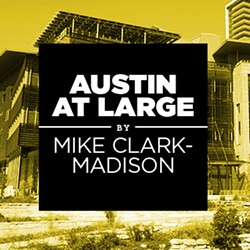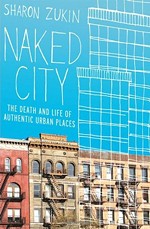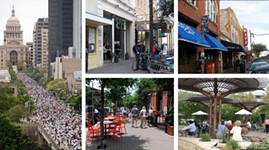Austin @ Large: Big-Box Breakdown
Impact? What impact? The City's slothful retail strategy.
By Mike Clark-Madison, Fri., July 9, 2004

You'd never have known such sarcasm lay beneath the dais as council members patted consultant Jon Hockenyos on the head and thanked him for a job well done. And perhaps it was well done, if the "job" was to make big-box go away as an "issue" that City Hall might be tempted to, you know, actually respond to in an innovative and, yes, progressive way. (It's hard to blame Hockenyos, since obviously his safe-as-milk report would not have interrupted the council's busy schedule if it were not what many at City Hall had wanted to hear.)
As it stands, the agenda is set: We banned 'em over the aquifer, and we're gonna make them pretty with new design standards, so what else can we do, the city asks? Look at our study! It says the Wal-Marts and Home Depots don't really compete with small local indie businesses, and it says we need to approve 'em to maintain our share of the regional retail market and keep pulling in sales tax revenue. Y'know, as long as we keep doing the Keep Austin Weird thing, all will be rosy. Let's move on to something else.
Ahem. Communities around the nation and the world – from inner-city Los Angeles to upscale Cape Cod, and from Dublin, Calif., to Dublin, Ireland – have moved assertively to protect themselves from the depredations of big-box retail. But the supposedly progressive, regulation-happy city of Austin will do little but wring its hands and abdicate its responsibility (under both state law and the City Charter) to regulate land use (and, in the process, economic activity) in accordance with a comprehensive plan. Whatever you think of the city's big-box performance so far, it falls far short of "comprehensive."
Open Your Eyes
Let me say that, for all my railing against big boxes, my local-level concerns mostly revolve around land use and infrastructure. (That's why I think design standards are more than just a superficial response, though hardly a complete one.) As responsible corporate citizens, in my view, they're a mixed bag, with Wal-Mart and Lowe's at the bottom. And on the cultural front, I sorta agree with Hockenyos: Some small local businesses can compete effectively with Wal-Mart simply by not being Wal-Mart. I'm no great fan of mindless consumer culture, but I do think it borders on elitist to pretend that every community can, or should, either support local Weirdness or do without.
But even I am not such a useless tool (most of the time) as to believe that there is no real competition between big-box chains and locally based retail, given there's only about 10,000 examples across the country of small-town economies being devastated by the arrival of Wal-Mart. I remember spending some time on Kauai right after Wal-Mart and some other big boxes got there, hearing locals say the impact on existing businesses was worse than that of Hurricane Iniki. Again, the unique boutique-hippie-tourist lifestyle sector of the Garden Isle did fine. It was the grocers, the people selling work clothes, the garages and pharmacies and small-appliance dealers who went under almost overnight.
By sucking all the routine retail trade off the surface of the island and depositing it all in one place, Wal-Mart created on Kauai exactly the sort of "impact" that Hockenyos' study could have analyzed but didn't, and that the City Council should be concerned about but isn't. Wal-Mart drove wages (in a locale that already had affordability and social-equity problems) down to poverty levels; it created massive traffic snafus on an island that (by public demand) was "underserved" by road and transit infrastructure; and it ended up gentrifying communities that had formerly been able to support diverse mixed-income retail, but which now had to either go yuppie or die.
A Wal-Mart on Austin's Eastside – say, on the Featherlite tract – could do all the same things, and perhaps other bad things besides, impacts that wouldn't be offset by the everyday low prices or the fresh New Urban design standards. For City Hall to ignore the potential harm of such untrammeled big-boxing is simply slothful. We can quibble over whether Hockenyos was slothful as well – I mean, I only had to go on vacation to "research" this issue, which has played out all over the planet – or about what happened to his (or city staff's) supposed charge to examine the impact of big boxes on infrastructure and public safety. Point is, this issue is a long, long, long way from being fully explored, let alone resolved.
Pay for Privileges One problem – and this is not a problem unique to big-box retail – is that Austin has yet to figure out, or settle on, a way to put a price tag on all the externalized costs of large-scale developments. Most small businesses locate in existing buildings and tap existing infrastructure. (Some large employers do as well – one of the few undiluted upsides of the Home Depot data-center deal.) Most Wal-Marts don't. The various impact fees paid by developers are not what you'd call the product of exact science. More indirect impacts – say, on nearby property values, or on the maintenance needs of nearby roads, or on the health of neighborhoods anchored by suddenly endangered commercial nodes, or on social services for the working poor earning Wal-Mart's everyday low wages – are even less likely to be measured, let alone compensated. And then there's the opportunity cost – the expense, or the benefit, to the community of putting something other than big-box retail on a particular site, relatively speaking.
The fruits of that labor, along with design standards and citywide planning principles and size caps and such and all, could well be folded into one easy-to-use tool – a new zoning category for large-scale retail. (Right now, city code treats Wal-Marts as if they were really, really, really, really big 7-Elevens.) The city can't require a living wage as a condition of zoning, but it could provide incentives (fee waivers and such) to big-boxers who do right by their employees. In fact, just that kind of assertiveness on the part of the council, and that kind of linkage of city support to corporate citizenship, was proposed last year by the Mayor's Task Force on the Economy. The author of the relevant recommendations? Why, Jon Hockenyos, of course. ![]()
Got something to say on the subject? Send a letter to the editor.










